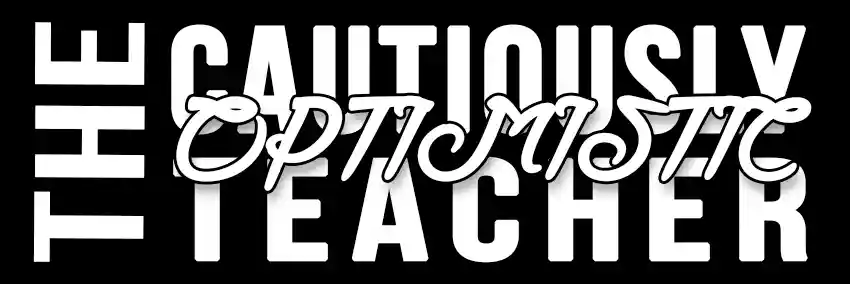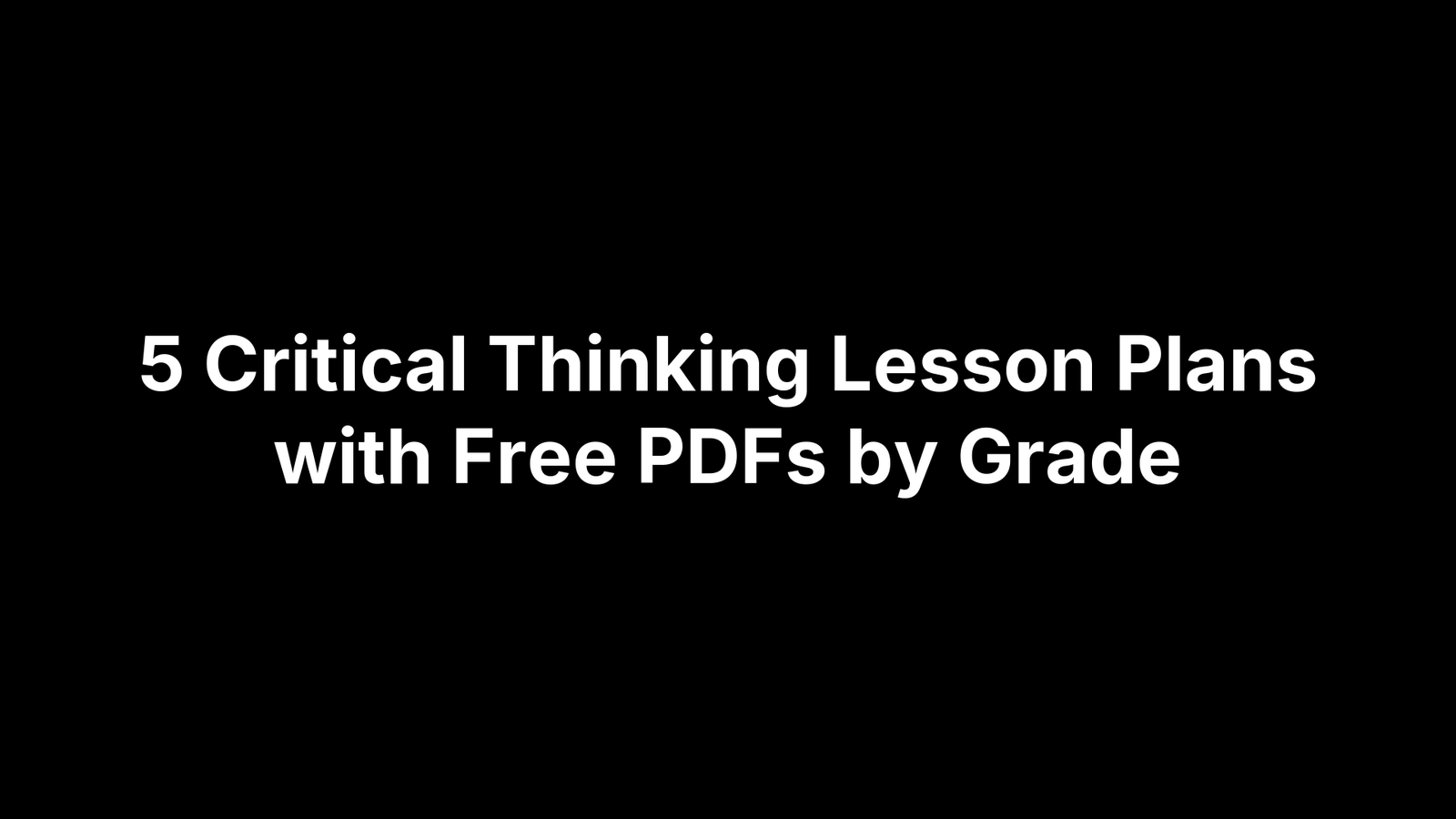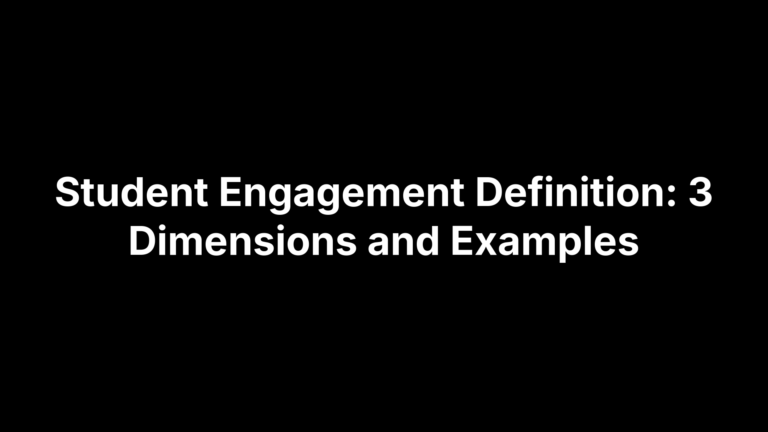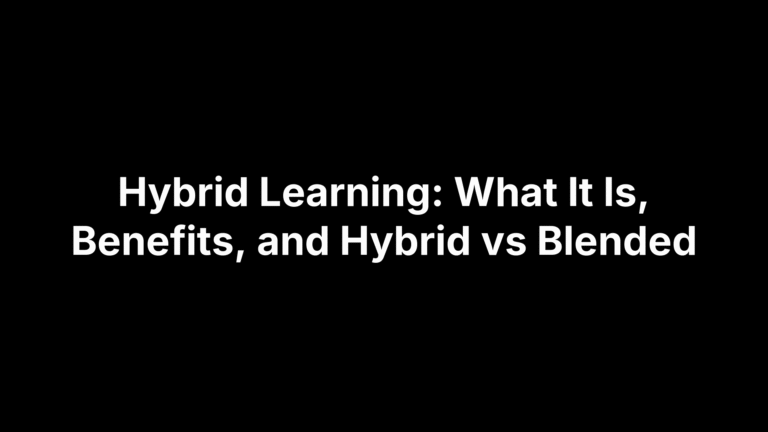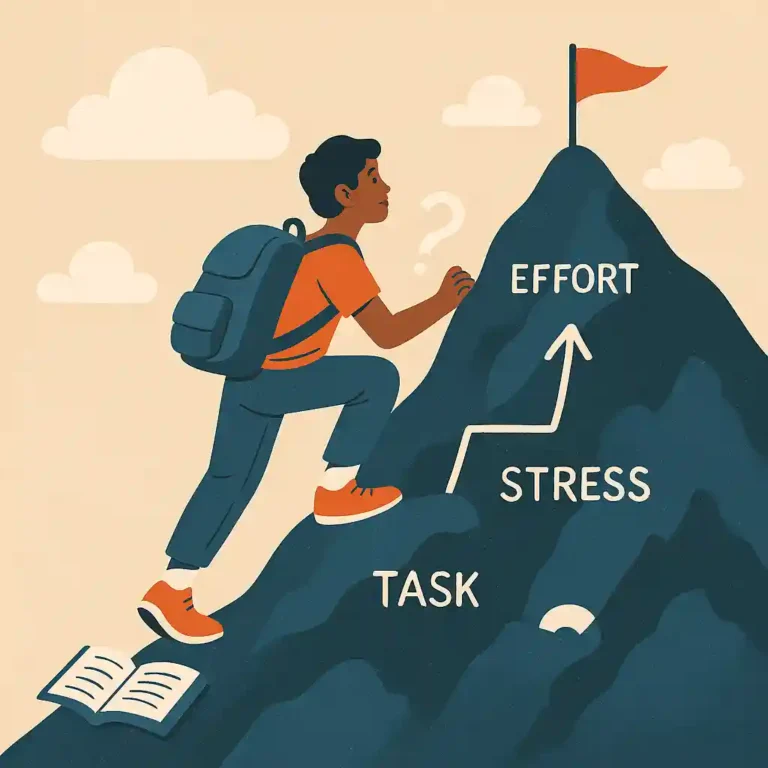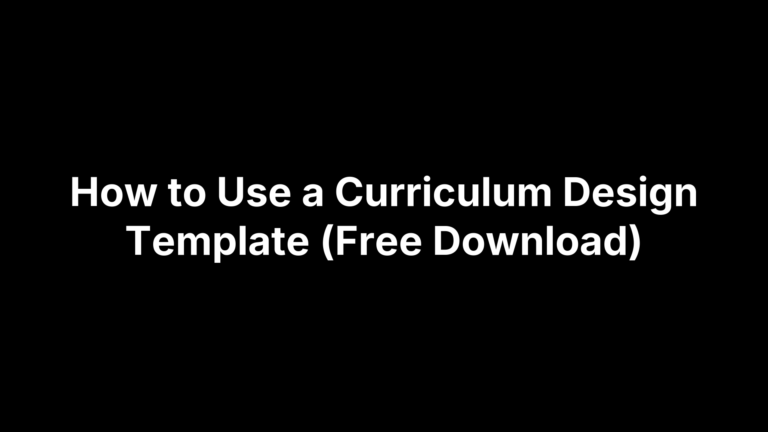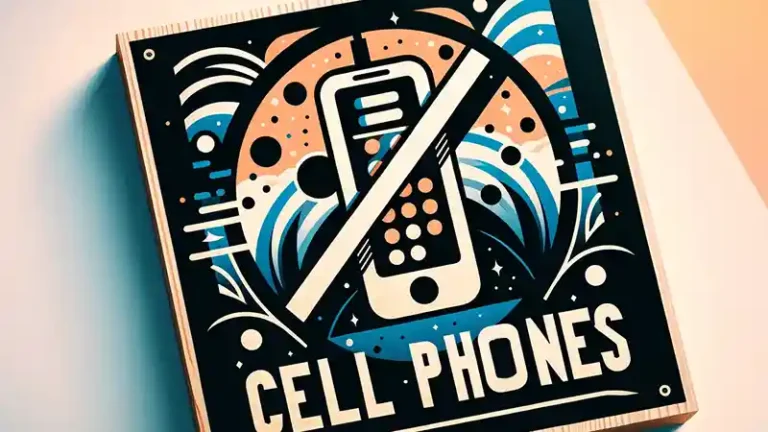5 Critical Thinking Lesson Plans by Grade
You want students to move beyond “right answers” to reasoned answers—but finding ready-to-teach, age-appropriate critical thinking lessons (with rubrics, models, and minimal prep) can eat up your planning time. Maybe you’ve got a unit looming, admin asking for higher-order thinking evidence, or you just know your class needs practice separating facts from takes. What you need are quick wins: structured activities that build habits of inquiry without reinventing your week.
This guide gives you five classroom-tested lesson plans—one for each grade band from K–2 through 11–12—with free, printable PDFs. Each plan includes a clear objective, skills and standards alignment, a quick procedure, materials list, assessment tools, and built-in differentiation. You’ll get “Picture Detectives” for early grades, fact vs. opinion stations for upper elementary, a CER news lab using the SIFT method for middle school, a Socratic seminar with argument mapping for grades 9–10, and “Bias Busters” on assumptions and expert testimony for grades 11–12. Download, photocopy, or assign digitally, then teach. Let’s get your students asking sharper questions, citing stronger evidence, and explaining their thinking—starting with the first plan below.
1. Grades K–2: Picture detectives — observe, sort, and explain (free PDF by The Cautiously Optimistic Teacher)
In this K–2 critical thinking lesson plan, students become “picture detectives.” They closely observe high-interest images, sort them by a rule they can justify, and explain their choices using kid-friendly frames: “I see… so I think… because…”.
What you’ll download (free PDF)
You’ll get a printable pack with a teacher guide, picture cards, sorting mats, sentence frames, an exit ticket, and a simple single-point rubric—ready for print or digital use with slides.
Skills and standards
Students practice observation, categorization, and evidence-based explanation. The lesson supports early ELA speaking/listening and writing, plus science practices of making observations and communicating findings.
- Observe carefully
- Sort by a defensible rule
- Explain using “because” evidence
Time and materials
Plan for 25–35 minutes: a short model, small-group sorting, and quick shares. Use the PDF, scissors/glue or drag-drop slides, crayons, and clipboards or mini whiteboards.
- Printed/digital cards and mats; sentence frames; exit ticket
Quick procedure
Students learn the routine once; you can reuse it with new images all year.
- Model: Think-aloud how to spot details and propose a sorting rule.
- Sort: Pairs sort pictures and name their rule.
- Explain: Share one choice using sentence frames.
- Reflect: Complete the exit ticket.
Assessment and rubric
Use the single-point rubric during walk-arounds and collect exit tickets for quick evidence. Provide one glow/one grow note tied to the criteria.
- Observes details
- Sorts by clear rule
- Explains with “because”
Differentiation and extensions
Support emerging readers and multilingual learners with visuals, word banks, and oral recordings; let students point and speak before writing. Extend by challenging “two rules,” “odd one out,” or “explain it to an alien” to surface assumptions.
- Scaffold: Choose from two rules; sentence frames with visuals
- Challenge: Create a new rule and defend it
- Language: Picture-word bank; partner rehearsal
- Transfer: Repeat with science or social studies images
2. Grades 3–5: Fact vs. opinion stations — evidence scavenger hunt (free PDF)
Turn everyday claims into a game of proof. In this upper–elementary critical thinking lesson plan, students rotate through stations to sort statements as fact or opinion—and then go on an “evidence scavenger hunt” to verify factual claims with kid-friendly sources.
What you’ll download (free PDF)
A ready-to-teach packet with a teacher guide, 24 statement cards (mixed topics), station signs, a student booklet (T-charts + evidence tracker), an anchor chart, a single-point rubric, and an answer key with rationales.
Skills and standards
Students practice distinguishing fact from opinion, citing evidence, and explaining their reasoning—core to evaluating sources and arguments found online and in print.
- Classify: Fact vs. opinion with justification
- Cite: Locate and record confirming evidence
- Explain: Share reasoning using sentence frames
Time and materials
Plan 35–45 minutes for model, two station rounds, and debrief. Use printed cards and preselected kid-safe pages (or printouts) to speed search time.
- Statement cards; station signs; student booklet; rubric
- Clipboards or notebooks; pencils; timers
- Optional: QR codes to curated articles/videos
Quick procedure
Teach the routine once, reuse with new sets all year.
- Model with a T-chart and think-aloud.
- Station 1: Sort statements; write a “because” reason.
- Station 2: Evidence hunt for “fact” claims; capture title/source.
- Debrief: Revisit one tricky card; class vote and defend.
Assessment and rubric
Use the single-point rubric during rotations and collect booklets. Finish with an exit slip: reclassify one statement and explain why.
- Accuracy: Correct sort + match to evidence
- Evidence use: Specific, credible source noted
- Reasoning: Clear “because” statement
Differentiation and extensions
Support with color-coded sentence frames and pre-highlighted sources; allow oral explanations before writing. Challenge with ambiguous claims, student-written cards, or a brief debate.
- Scaffold: Word bank; modeled exemplar; fewer cards
- Challenge: Create-and-swap statements; defend a reclass
- Transfer: Apply routine to a short news blurb in science/SS
3. Grades 6–8: CER news lab — investigate viral claims with SIFT (free PDF)
Headlines travel faster than facts. In this middle-school critical thinking lesson plan, student teams investigate a “viral claim” using SIFT (Stop, Investigate the source, Find better coverage, Trace claims to the original). They log what they find, then craft a one-paragraph CER (Claim, Evidence, Reasoning) that clearly defends a verdict: credible, questionable, or false.
What you’ll download (free PDF)
A classroom-ready kit with a teacher guide, 16 viral-claim cards (QRs + print clippings), SIFT checklist mini-poster, note-catcher, CER graphic organizer, model/exemplar, single-point rubric, and exit ticket.
Skills and standards
Students evaluate source credibility, separate fact from opinion, and write evidence-based explanations aligned to argument writing and media literacy practices.
- Apply SIFT: Vet sources and trace to originals
- Cite evidence: Quote/paraphrase with source info
- Write CER: Clear claim + relevant evidence + sound reasoning
Time and materials
Plan 45–60 minutes for model, inquiry, and CER writing. Use the PDF pack, devices with internet (or printed articles), highlighters, and sticky notes.
Quick procedure
- Model SIFT on a teacher-chosen post; think aloud each step.
- Teams pick a claim card; complete the SIFT note-catcher.
- Draft a CER paragraph; include at least two cited pieces of evidence.
- Share verdicts; quick gallery walk and debrief on tough calls.
Assessment and rubric
Use the single-point rubric for SIFT logs and CERs; spot-check citations. Optional 30-second “defense” where one student justifies the team’s verdict.
- Source checks: Appropriate use of SIFT
- Evidence quality: Specific, relevant, traceable
- Reasoning: Connects evidence to claim; addresses context
Differentiation and extensions
- Scaffold: Pre-curated credible/iffy sources; color-coded organizer; sentence stems for claim/reasoning
- Challenge: Students locate their own viral claim; include counterevidence; produce a 1-slide “verdict” with links
- Transfer: Reuse CER + SIFT with science or social studies articles
4. Grades 9–10: Socratic seminar + argument mapping on a current issue (free PDF)
Give students the mic—and a map. In this high school critical thinking lesson plan, learners prepare with a short, timely text, build an argument map to visualize claims, evidence, and counterclaims, then run a Socratic seminar that rewards citing sources, asking probing questions, and revising thinking.
What you’ll download (free PDF)
The packet is built for a single period or two mini-blocks, with print or digital options.
- Teacher guide: Objectives, setup, timing, and discussion norms
- Student prep sheet: Focus questions and annotation cues
- Argument map templates: Paper and slide versions
- Model text + optional alt viewpoint: Short, accessible articles
- Sentence stems: For probing, building on, and qualifying claims
- Single-point rubric + exit ticket: Seminar and map criteria
Skills and standards
Students practice close reading, evidence-based discussion, and argument writing—key ELA speaking/listening and reasoning skills.
- Map arguments: Claim, reasons, evidence, counterclaim, rebuttal
- Discuss productively: Cite the text, question, and build ideas
- Revise thinking: Update the map after hearing others
Time and materials
Plan 50–60 minutes (or two 30-minute sessions). Use the PDF pack, the selected text(s), timers, and either chart paper/markers or slides/post-its.
Quick procedure
Model once; the routine scales to any content.
- Read and annotate the text with the prep sheet.
- Draft an argument map (claim → reasons → evidence → counter).
- Run a Socratic seminar (inner circle talks; outer circle tracks evidence).
- Debrief and revise maps; complete the exit ticket.
Assessment and rubric
Assess both the talk and the thinking. Use the single-point rubric during the seminar and collect revised maps.
- Evidence use: Specific citations, accurate paraphrase/quotes
- Reasoning: Clear links between evidence and claim; counters addressed
- Collaboration: Builds on peers, asks clarifying/probing questions
- Reflection: Map revisions show learning from discussion
Differentiation and extensions
Meet students where they are, then raise the ceiling.
- Scaffold: Highlighted texts, role cards (questioner, summarizer), stems
- Challenge: Add data visuals to the map; identify assumptions or fallacies; write a 200-word rebuttal
- Transfer: Reuse with science controversies or historical editorials
5. Grades 11–12: Bias busters — evaluating assumptions and expert testimony (free PDF)
Senior students step into a courtroom mindset: surface assumptions behind a claim, interrogate competing expert testimony, and write a concise case brief that defends a judgment. This plan draws on proven “evaluating assumptions” and “expert testimony” moves common in critical thinking lesson plans.
What you’ll download (free PDF)
You’ll get a turnkey packet designed for one class or two short blocks.
- Teacher guide: Timing, modeling script, and sample answers
- Case set: Claim, two expert bios/testimonies, and a credibility checklist
- Student tools: Assumptions inventory, case-brief template, single-point rubric, exit ticket
Skills and standards
Students practice spotting bias, weighing expertise, and justifying conclusions with evidence—key for college-ready reading, argument writing, and media literacy.
- Identify assumptions: What must be true for the claim to stand?
- Evaluate expertise: Credentials, methods, track record, and conflicts
- Argue clearly: Claim, evidence, counterpoint, and warranted reasoning
Time and materials
Plan 50–60 minutes (or two 30-minute sessions). Use the PDF packet, highlighters, and optional devices for quick credential checks.
Quick procedure
Model once, then let teams work the case and defend their call.
- Hook: Present the claim; students jot possible assumptions.
- Analyze experts: Use the credibility checklist to compare testimony.
- Decide and brief: Write a one-page case brief with a counterpoint.
- Stand and defend: 60-second oral justification; classmates note one strength/one risk.
Assessment and rubric
Assess the brief and defense with a single-point rubric.
- Assumptions: Specific, relevant, and tested against evidence
- Credibility analysis: Concrete details (methods, conflicts, sourcing)
- Reasoning: Clear warrant linking evidence to the verdict; counter addressed
Differentiation and extensions
Support all learners while raising the ceiling on rigor.
- Scaffold: Sentence frames, annotated sample bio, and a simplified checklist
- Challenge: Add a third “star expert” that disagrees; require a limitations section
- Transfer: Convert the brief into a 200-word policy memo or an op-ed paragraph; “explain it to an outsider” rewrite to surface hidden assumptions
Next steps
You now have five plug-and-play critical thinking routines you can teach tomorrow—complete with rubrics, models, and reflection. Start small, keep the language consistent, and spiral the moves across content: observe and sort, separate fact from opinion, SIFT sources, map arguments, and pressure-test assumptions. The more you reuse the routines, the faster students internalize them.
- Pick one plan: Print or assign the PDF and set a 30–45 minute window.
- Model once: Think aloud the verbs (observe, cite, map, counter).
- Collect evidence: Use the single-point rubric + exit ticket every time.
- Spiral weekly: Reuse the routine with new content in ELA, science, or SS.
Want to move even faster? Download the free PDFs above, then use our Differentiated Instruction Helper, Worksheet Maker, and Question Generator to tailor follow-ups for your learners. Explore more resources and sign up for the weekly roundup at The Cautiously Optimistic Teacher.
